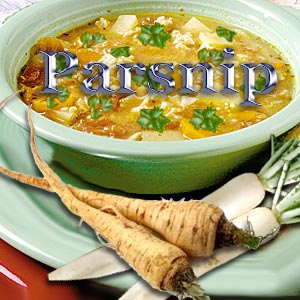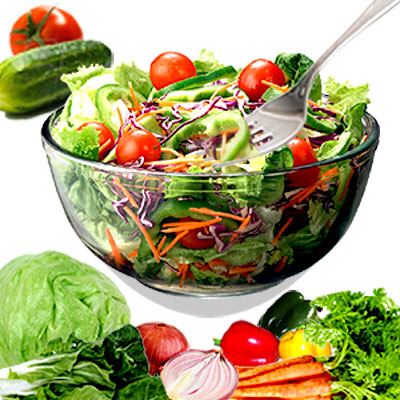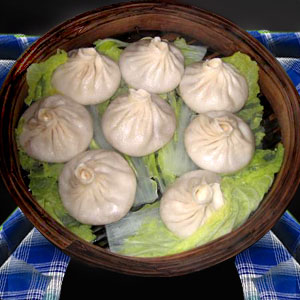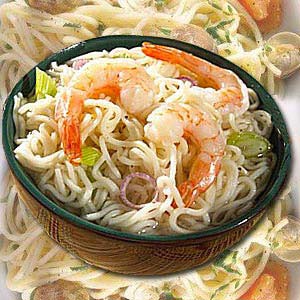Parsnip Soup

Parsnip is a root vegetable that belongs to the family of carrots. Parsnips look a lot like carrots but are much paler in color and stronger in flavor. A traditional American vegetable, parsnip is used extensively by the Europeans too. Parsnip derived its name from the French word pastinaca, the nip in the word pointing out that parsnips are like turnips. Parsnips can be eaten raw or cooked. Learn how to incorporate parsnips into your recipes. Take note of a simple parsnip soup recipe.
Origin of Parsnips
Parsnips were cultivated and consumed in Eurasia since ancient times and were used very frequently in all dishes until potatoes replaced them. In medieval Europe sugar was an uncommon and expensive commodity and parsnips were used as they were both starchy and sweet. With the growing popularity of sugar and potatoes in the 18th century, parsnips slowly started to lose their significance. In America, parsnips were brought in by the early European settlers. They used parsnips as a sweetener until the 19th century after which the sweet beets replaced the parsnips as sweeteners.
Parsnips are winter vegetables because the complete flavor for parsnip is developed only when it is exposed to close to freezing temperatures for about 2 - 4 weeks during fall and early winter. This exposure converts the starch in the root of the parsnip into sugar thus giving it a sweet, strong and special taste. Parsnips have a sweet nutty flavor. This flavor is fully developed only if the parsnips are exposed to the winter properly.
More on parsnips
Fresh parsnips have a buttery-soft texture when cooked whereas old parsnips become very fibrous and taste bitter when cooked. Over-cooked parsnips get sticky and turn into a paste. If stored in a clean and cool place parsnips can stay fresh for weeks together. Parsnips must be cleaned just like carrots by scrubbing them well. Leave muddy parsnips as they are till you decide to cook them. The mud protects the parsnips.
Small parsnips are sweeter than the large ones and they are less woody too. Pick a parsnip that is firm and that is less damaged at the root. Parsnip and its leaves are known to cause skin allergy to some. Parsnip is a staple winter vegetable used in soups, stews etc. Parsnips can be boiled, used in soups, stews and casseroles, or roasted. Roasted parsnip is an important dish in Christmas dinners and in traditional Sunday roasts too.
Parsnips are rich in vitamins and minerals. They have high potassium contents of nearly 660 mg per 100 g. Parsnips have good fiber content and make for excellent dietary fiber. 100 g of parsnip contains about 55 calories of energy. They also provide moderate amounts of Vitamins A, B and C.
Cooking parsnips
- You can choose to merely steam and boil the parsnips or roast them in the oven.
- Use parsnips when you run out of carrots for recipes.
- Remember that peeled parsnips will turn dark so use them right away.
- Traditional recipes use parsnips for jams and desserts.
- Parsnip wine is known for its rich golden hue and flavor akin to sherry.
- Use basil, thyme and tarragon to flavor parsnip dishes.
Parsnip recipe
Parsnip, chickpea curry
Parsnips 2
Chick peas 200 g cooked
Onion sliced
Fresh ginger ½ inch, peeled and grated
Garlic 4 cloves, peeled and crushed
Cumin seeds ½ tsp
Fresh chili 1 chopped
Coriander seeds ½ tsp
Tomatoes chopped
Fenugreek seeds ½ tsp
Fresh coriander leaves
Heat a large pan without oil and add cumin, fenugreek and coriander seeds. Roast for about 2 minutes. Wait until they pop, remove from heat and crush them using a pestle and mortar or in a grinder. Heat oil in a pan and sauté onion, garlic, chili and ginger until they become soft. Now add the ground seeds and sauté for another 2 minutes. Scrub or peel the parsnips and cut them into ½ inch cubes. Add it to the pan and stir well until the mixture coats well on the parsnips. Cover and cook for 5 minutes.
Add tomatoes, chick peas, and stir well, cover and cook on low fire for about 20 minutes. Cook until the parsnips are tender. Remove from heat and sprinkle the coriander leaves.
Parsnip soup recipe
Parsnip 3, peeled and chopped
Onion ½ cup chopped
Peeled gingerroot 1 tsp minced
Garlic 1 clove minced
Celery ½ cup thinly sliced
Carrot ½ cup thinly sliced
Unsalted butter 2 tbsp
Dried thyme 1/8 tsp
Chicken broth 2 cups
Freshly grated nutmeg to taste
Melt butter in a heavy bottom saucepan to cook onion, garlic, carrot, celery, gingerroot and the thyme over low heat. Stir continuously while cooking until the onions get soft. Add parsnips and the broth and bring the liquid to a boil. Cover and cook the mixture for about 15 minutes, until the vegetables are tender. Puree the soup using a blender and pour it in the pan. Add the nutmeg and add enough water to get the desired consistency for the soup. Add salt and pepper.
Top of the Page: Parsnip Soup
Tags:#parsnip #parsnip soup #parsnip soup recipe
 Food and Nutrition Facts
Food and Nutrition Facts Chamomile
Parsnip Soup
Dim Sum
Gazpacho Soup
Whole Grain Cereal
Jicama Nutrition
Bok Choy Stir Fry
Chia Seeds Benefits
Teff Nutrition
Kaniwa
Flax Seed
Wheatgrass Benefits
Kelp Benefits
Types of Chili Peppers
Medicinal Benefits of Pomegranate
Arugula Leaves
Maca Root
Pitaya Fruit
Benefits of Celery
Leek
Asparagus Benefits
Oyster Stew
Oyster Mushroom
Lupin Beans
Quinoa
Freekeh
Extra Virgin Olive Oil
Dill Pickle
Sauerkraut
Fat Burning Foods
Nutrition Chart
Food Combining
Calorie Counter
calories ...
Non Alcoholic Beverage
Punch Recipes
Food Label Nutrition
Homemade Sausages
Cooking Steak
Eating on a Budget
Budget Friendly Recipes
Quick Recipes
 Healthy Packed Lunch
Healthy Packed Lunch Overnight Oats Recipes
Eggplant Casserole
Brunch Recipes
Burrito Recipes
Muffin Recipes
Cupcake Frosting
Apple Crisp
Stir Fry Cooking
Seafood Salad Recipe
Cooking Corn on the Cob
Finger Food Recipe
Sandwich Recipe
Bread Stuffing Recipes
Easy Chili Recipes
Picnic Recipes
Edible Mushroom Recipes
Mushroom Soup Recipes
Dip Recipe
Tapas Recipe
Corned Beef Recipe
Canned Salmon Recipe
Tilapia Recipes
Crumb Cake
Flourless Chocolate Cake
Regional Food
 Lasagna Recipe
Lasagna Recipe Peruvian Ceviche
Chinese Food Recipe
Vietnamese Food Recipe
Malaysian Food
Korean Food Recipe
Indian Curry Recipe
Edible Rice Paper
Mexican Food Recipe
Quesadilla
Guacamole Dip
Italian Food Recipe
Spanish Food Recipe
Kosher Food
Falafel Recipe
Tandoori Chicken
Noodles
Canape
Couscous
Meatloaf
Chowder
Gumbo Recipe
Crockpot Recipes
Moroccan Food
Healthy Food
Pre Workout Snack
Matcha Tea
Simple food Swaps to Lose Weight
Foods to Beat Stress
Foods to beat Insomnia
Bone Density Foods
Prebiotic Foods
Kefir Grains
Agave Nectar
Spicy Trail Mix
Pesto Sauce
Homemade Hummus
Crab Cake Sauce
Bamboo Shoots Nutrition
Lemon Grass Plant
Butter Beans Recipes
Loose Green Tea
Seaweed Nutrition
Healthy Food
Low Fat Granola Bar
Steel Cut Oatmeal
Fruit Pizza
Pizza Toppings
Green Smoothie
Healthy Meal Planning
Delicious Mealtime Recipes
Heart Healthy Fats
Healthy Heart Recipe
Healthy Dinner Recipe
Healthy Dessert Recipe
Healthy Fast Food
Healthy Kid Recipe
Probiotic Food
Diabetic Friendly Foods
Fruit Salad Recipe
Bread Pudding
Tofu Recipe
Oat Bran
Broccoli Salad
Avocado Recipe
Iron Rich Food
Brain Foods
Antioxidant Food
Natural Diuretic
Low Fat Cooking Tips
Rice Pilaf Recipe
Low fat Chicken Recipe
Food Tips

Sous Vide Cooking Technique
Natural Sugar Substitute
Stevia Sugar Substitute
Sunflower Seeds Nutrition
Bouquet Garni
Cake Decorating Tips
High Satiety Foods
Thanksgiving Dinner
Safe Food Storage
Frozen Food Storage Tips
Cold Storage Food Tips
Leftover Recipe
Food Pyramid
Dairy Free Food
Microwave Cooking
Food Intolerance
Homemade Ice Cream
Apple Cider Vinegar
Benefits of Honey
Beverage Cooler
Food Poisoning Symptom
Food Allergy Symptom
Food Addiction
Top of the Page: Parsnip Soup
Popularity Index: 101,096

